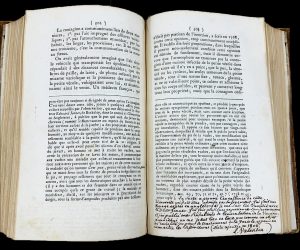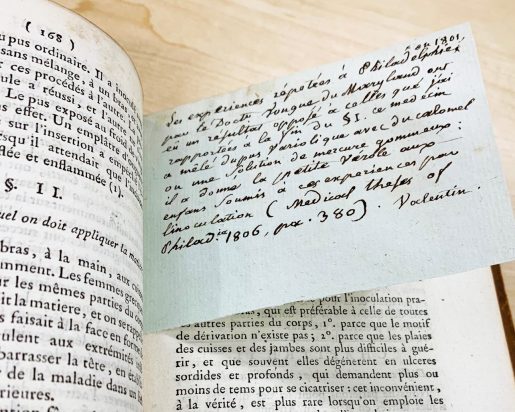
The authors of the historical and practical treatise on inoculation, Traité historique et pratique de l’inoculation (Paris 1799), were both champions of prophylaxis experimentation with preventive treatments for smallpox. Both were French physicians and military surgeons. Francois Dezoteux (1724-1803) participated in the War of the Austrian Succession. He established a school of military surgery in Paris, served as inspector of military hospitals, and studied the success of the Suttonian method of inoculation in England. Louis Valentin (1758-1829) served as military surgeon on Saint-Domingue (in present-day Haiti), but in 1793 he had to flee to the United States, where he was in charge of treating French sailors in hospitals in Virginia. While there, he gained experience in inoculation against smallpox.
Their book gives a history of the smallpox disease and its inoculation. It discusses how to prepare subjects and explains the procedure. The work provides guidance for post-inoculation observations. It points to the ease and efficacy of the treatment and proposes a plan for the inoculation of the public. The treatise also includes a description of the Suttonian method, which helped the Sutton family turn the propagation of smallpox inoculation into a successful business, keeping it a family secret until 1796. Additionally, it contains a report of the first trial inoculation performed in Salpétriere Hospital by Pinel and Leroux in 1799.
The timing of publication and the provenance of the book are of special note. Inoculation had been practiced in Europe widely since 1721, but Traité historique et pratique de l’inoculation appeared shortly after Jenner introduced vaccination with cowpox (1798) and propelled efforts at fighting smallpox to a new level. The authors took note of this important development with a lengthy footnote describing Jenner’s breakthrough. Dezoteux died in 1803, but Valentin became an enthusiastic advocate of this new development. He performed the first vaccinations in Lorraine in 1800. He participated himself and sent out the cowpox virus to surrounding districts, encouraging his colleagues to join the organized effort to vaccinate the country.

The Falk Library copy of this book is bound in a beautiful leather binding and is full of handwritten annotations by author Louis Valentin. He amended the footnote about Jenner’s discovery with the note: “The following proves the excellence of this discovery which must be admitted exclusively. I made an express trip to England and made friends with Dr. Jenner. I have done several experiments on animals and published my vaccine inoculation results. Today, I no longer read this book except as an object of curiosity, for the treatment of smallpox and to know the distinctions.” This note was added in 1806 after he published a book on vaccination in France (1802), a treatise on yellow fever in America (1803), and a biographical sketch of Jenner (1805).
~Gosia Fort